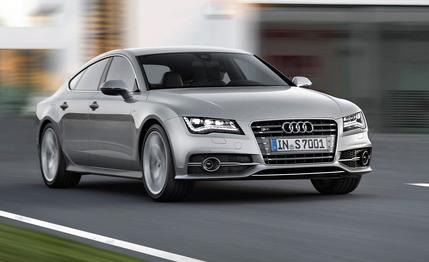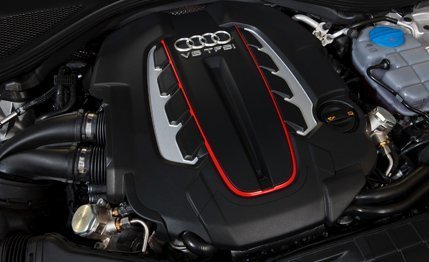 First Drive Review
First Drive Review
Looking at the Audi S7, we find it hard to believe hatchbacks ever went out of fashion. Few cars on the market have the presence of the A7 and its new high-performance derivative. While other manufacturers were busy building market-research-driven hatchbacks—vehicles like the BMW 5-series GT and Mercedes-Benz R-class—Audi simply tasked its designers with creating a beautiful five-door. The A7 doesn’t want for much, except perhaps more muscle than the 310 hp provided by its supercharged V-6.
Power to the Five-Door People
The S7 is powered by a 420-hp variation of the brand’s new twin-turbocharged 4.0-liter V-8. This engine, at the same output level, also motivates the new S6; it makes more power in the S8 and base Bentley Continental GT. There’s considerable commonality with the naturally aspirated 4.2-liter FSI V-8 still offered in other models, but the new engine features a number of enhancements, chief among them a pair of twin-scroll turbochargers and an indirect intercooler, all placed in the vee between the cylinder heads. The crankshaft design carries over from the 4.2 FSI, with reduced stroke; friction losses are significantly reduced. A cylinder-deactivation system—it closes the valves of cylinders 2, 3, 5, and 8 under light loads—helps fuel economy noticeably, especially when cruising in higher gears at constant speed. An engine stop-start system is standard.

In the S7, the 4.0 TFSI engine is mated to a strengthened DL501 seven-speed wet dual-clutch transmission; the S8, with its 520-hp "4.0 TFSI-plus" engine, is coupled to an eight-speed torque-converter automatic. By default, 60 percent of the S7’s power is sent to the rear and 40 percent to the front. Depending on available traction, the front-to-rear split can vary between 20/80 and 70/30. A brake-based torque-vectoring function is standard; the optional sport differential, which provides true mechanical torque, can transfer almost all the torque to one of the rear wheels to enhance agility. And that's a good thing, given the S7's projected weight of about 4350 pounds. An electronically adjustable air suspension is standard; the steering is electromechanical. Dynamic steering with an adjustable ratio is optional, as is a carbon-ceramic braking system.
Make with the Quickness
The results are entirely to our liking. On the road, the S7 feels considerably lighter than it actually is. The car's limits are high, and its fluid responses make it easy to control. In the dynamic setting of the adjustable chassis, this car is harder and sharper than the S8. The dual-clutch transmission provides seamless, quick shifts, but when you push the car, the gearbox makes itself noticed. This is preferable to the S8 transmission’s behavior, as the larger car tends to gloss over its gearchanges. Only the S7's sheer size will keep most drivers from pushing it on narrow country roads like a sports car. We were pleasantly surprised by the electromechanical steering. Once again, Audi has done a better job than BMW in this area.